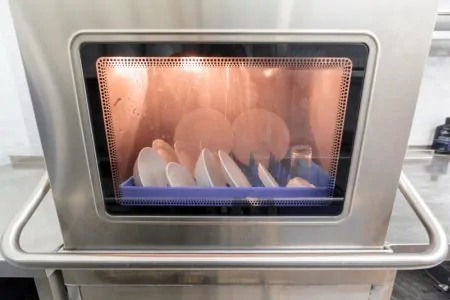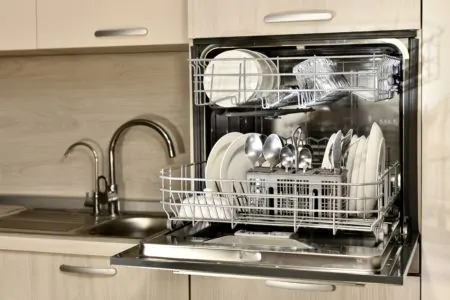Dishwashing is nobody’s favorite chore. But we’ve come a long way since the beginning of time.
These 20 dishwashing statistics and facts might even make you thankful for all the handy dishwashing tools we have now.
We’re going to dive deep into the history of dishwashers, talk a little about their efficiency, and share some industry facts. Keep reading to learn more.
Top 20 Dishwashing Statistics and Facts
- The first dishwasher was invented in 1850 by Joel Houghton.
- Josephine Cochrane invented the first dishwasher that actually worked and saved time.
- In 1924, William Howard Livens invented a domestic dishwasher similar to what we use today.
- Dishwashers became more popular in 1950, after the war.
- Dishwashers were common by the 1970s.
- The average dishwasher costs around $35 a year to run.
- Look for the Energy-Star certification if you want a more eco-friendly dishwasher.
- Most dishwashers have various cycles, including an eco option.
- Dishwashers use a lot of energy — around 1.71 kilowatts per cycle.
- Heating the water is responsible for about 84 percent of a dishwasher’s energy.
- Dishwashers use less water per cycle. Using 27 gallons of water washing dishes by hand would be equal to three gallons in the dishwasher.
- A dishwasher does it all: rinses, washes, rinses again and dries.
- You shouldn’t wash non-stick pans, chef’s knives, or wooden items in the dishwasher.
- Dishwashers are more efficient than hand-washing since they use more concentrated detergent, steam, and powerful jets.
- Hand-washing your dishes is much less hygienic than using a dishwasher.
- The global dishwasher market was valued at 7.17 billion dollars as of 2020.
- The driving factor behind the growing market includes busier lifestyles, disposable income, and more hygiene awareness.
- The most popular type of dishwasher is stainless steel with rinse aid, LED touch panels, and soundproofing.
- Key dishwasher brands include Electrolux, LG, and Whirlpool.
- Asia-Pacific has a 34.8 percent share in the dishwasher market.
History of Dishwashers
If you own a dishwasher, it’s probably one of your most beloved household appliances. Ours is, for sure!
But who invented it? What was the first dishwasher like? Check out these facts; they might help you on your next trivia night.
- The dishwasher appeared in 1850: The first dishwasher was invented by Joel Houghton in America in 1850. It was slow and not at all efficient. It was wooden with a hand-cracked wheel which triggered water spraying over the dishes.
- A woman invented the first practical dishwasher: Because Joel Houghton’s invention was less than impressive, a woman named Josephine Cochrane came along to rectify it. She invented the first dishwasher that actually worked and saved time! She unveiled the hand-operated mechanical dishwasher at the 1893 World Fair.
- William Howard Livens made the next step: In 1924, a British man named William Howard Livens invented a domestic dishwasher. It was small and still not electric — but it had a front door, a wire rack, and a rotating sprayer. It’s pretty similar to what we use today.
- Dishwasher boom of 1950: After the war, dishwashers became more popular — but they were still only accessible to rich people. However, they were built into kitchen countertops, making them a more practical kitchen appliance.
- Dishwashers became common in the 1970s: By the 1970s, most new kitchens left space for a dishwasher. They were becoming much more common. During the 1990s, they increased efficiency with new features, such as soil sensors.
Dishwasher Energy Efficiency
Dishwashers use electricity. But does that mean that handwashing is more cost-effective? How much water does a dishwasher use?
Let’s look at a dishwasher’s energy efficiency, so we can understand a little more about its impact.
- Yearly costs: An Energy-Star certified dishwasher is energy efficient. They only run around $35 per year, saving you almost 4,000 gallons of water over the appliance’s lifetime (1).
- Features of Energy-Star dishwashers: There are a few features to look out for if you want a more energy-efficient dishwasher. This includes improving water filtration, efficient jets, clever dish rack designs, and soil sensors. The easiest way to know if your dishwasher is energy efficient is to look for the Energy-Star rating.
- Dishwashers have different cycles: If you want to be the most energy efficient while using your machine, try and use the eco or light wash cycle. This will use less water. Many dishwashers have more intense cycles, like pots and pan options, which will use more water.
- Dishwashers use a lot of energy: While dishwashers don’t use much water, they use a lot of energy (2). Depending on your model, your dishwasher probably uses between one and two kilowatts per cycle. This is equal to leaving your TV running for 20 hours. To lessen the electricity usage, use the lowest temperature possible.
- Heating is responsible for the most energy: Of the wattage a dishwasher uses per cycle, about 84 percent is used for heating the water. Fourteen percent is used for the motor, and two percent is used for the drain pump.
Dishwashing Vs. Hand-Washing
What about hand-washing dishes? Does it reign supreme? Or does the dishwasher do better?
If you hate washing dishes by hand, these dishwashing facts might make you happy.
- Dishwashers use less water: When you wash dishes by hand, you have to swap the water out quite often to ensure it’s clean. This means you could end up using around 27 gallons for the same amount of dishes a dishwasher can hold (3). On the other hand, dishwashers, on average, only use about three gallons of water per cycle (4)
- Dishwasher does it all: When you wash dishes by hand, you’re probably pre-rinsing, scrubbing, and then rinsing again to remove soap. This adds up to more and more water as you go.
On the other hand, the dishwasher has many jobs: it pre-rinses, washes, rinses again, and even dries your dishes for you! Way easier. - Some things aren’t for the dishwasher: While the dishwasher is a dream come true, it’s not capable of cleaning everything. You shouldn’t put non-stick pans, chef’s knives, or wooden items in the dishwasher. Wash those by hand, instead.
- Dishwashers are more efficient: No offense to your years of hand-washing dishes, but dishwashers are better at cleaning. They use more concentrated detergent and amazing jets to deep clean your dishes. As long as you don’t have a super old model, dishwashers can remove tough stains and sanitize your dishes with hot water and steam.
- Hand-washing dishes is less hygienic: Did you know that almost all dishwashers have bacteria (5)? The good news is that this bacteria isn’t harmful. On the other hand, your hand-washing routine is less hygienic because harmful bacteria can be on the sponge or rag you use to clean.
Top Tip
Many people rinse their dishes before putting them in the dishwasher, but this is unnecessary. You can save time, money, and water by scraping food into the garbage disposal or trash. And then put your dishes in the dishwasher — no need to rinse!
Dishwasher Industry Facts
Let’s look at some dishwasher industry dishwasher statistics and facts. We’ll investigate the market size, trends, and key information about dishwasher brands.
- 2020 dishwasher market size: The global dishwasher market size as of 2020 was valued at 7.17 billion dollars (6). Its estimated growth up until 2025 is 7.2 percent, leaving it at a 10.2 billion dollar value.
- Driving factors behind growth: It’s always interesting to look at what is causing the industry to grow. In this case, it includes more people eating out for meals, more restaurants, busier lifestyles, and more disposable income. A huge factor is also more awareness around health and hygiene; people want fewer germs in their homes.
- What type of dishwasher is the most popular?: Consumers opt for a stainless steel dishwasher because it is more energy efficient (7). This is because they require less energy for the drying cycle. Plus, stainless steel is easy to clean.
Buyers also want certain features, including rinse aid, LED touch panels, soundproofing, and glass protection. - Key dishwasher brands: The leading dishwasher brands globally are Electrolux, LG, Whirlpool, Bosch, Samsung, Asko, and Miele. These are all reliable brands that make durable and practical dishwashers.
- Asia-Pacific dominates the market share: As of 2019, Asia-Pacific had a 34.8 percent share in the market. Cleaning and hygiene products and home care items are on the rise in this region. This is specifically true in China, Japan, South Korea, and Taiwan.









